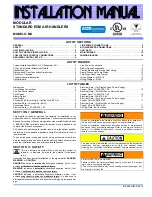
3
2 SHIPPING INSPECTION
Always transport the unit upright; laying the unit on its side
or top during transit may cause equipment damage. The
installer should inspect the product upon receipt for shipping
damage and subsequent investigation is the responsibility
of the carrier. The installer must verify the model number,
specifications, electrical characteristics, and accessories are
correct prior to installation. The distributor or manufacturer
will not accept claims from dealers for transportation damage
or installation of incorrectly shipped units.
2.1 Parts
Also inspect the unit to verify all required components
are present and intact. Report any missing components
immediately to Daikin or to the distributor. Use only fac-
tory authorized replacement parts (see Section 4). Make
sure to include the full product model number and serial
number when reporting and/or obtaining service parts.
2.2 Handling
Use caution when transporting/carrying the unit. Do not
move unit using shipping straps. Do not carry unit with
hooks or sharp objects. The preferred method of carrying
the unit after arrival at the job site is to carry via a two-
wheel hand truck from the back or sides or via hand by
carrying at the cabinet corners.
3 CODES & REGULATIONS
This product is designed and manufactured to comply with
applicable national codes. Installation in accordance with
such codes and/or prevailing local codes/regulations is the
responsibility of the installer. The manufacturer assumes no
responsibility for equipment installed in violation of any codes
or regulations.
The United States Environmental Protection Agency
(EPA) has issued various regulations regarding the in-
troduction and disposal of refrigerants. Failure to follow
these regulations may harm the environment and can
lead to the imposition of substantial fines.
Should you
have any questions please contact the local office of the EPA
and/or refer to EPA’s website www.epa.gov.
4 REPLACEMENT PARTS
When reporting shortages or damages, or ordering repair
parts, give the complete product model and serial numbers as
stamped on the product. Replacement parts for this product
are available through your contractor or local distributor. For
the location of your nearest distributor consult the white busi-
ness pages, the yellow page section of the local telephone
book or contact:
HOMEOWNER SUPPORT
DAIKIN NORTH AMERICA LLC
190001 KERMIER ROAD
WALLER, TEXAS 77484
855-770-5678
5 PRE-INSTALLATION CONSIDERATIONS
5.1 Preparation
Keep this document with the unit. Carefully read all in-
structions for the installation prior to installing product.
Make sure each step or procedure is understood and
any special considerations are taken into account before
starting installation. Assemble all tools, hardware and
supplies needed to complete the installation. Some items
may need to be purchased locally. Make sure everything
needed to install the product is on hand before starting.
5.2 System Matches
The entire system (combination of indoor and outdoor
sections) must be manufacturer approved and Air-Con-
ditioning, Heating, and Refrigeration Institute (AHRI)
listed.
NOTE:
Installation of unmatched systems is not
permitted. Damage or repairs due to installation of un-
matched systems is not covered under the warranty.
5.3 Interconnecting Tubing
Give special consideration to minimize the length of refrig-
erant tubing when installing air handlers. Refer to outdoor
AIR CONDITIONING OR HEAT PUMP INSTALLATION &
SERVICE REFERENCE for line set configuration guide
-
lines. If possible, allow adequate length of tubing such
that the coil may be removed (for inspection or cleaning
services) from the cabinet without disconnecting the
tubing.
5.4 Clearances
The unit clearance from a combustible surface may be
0”. However, service clearance must take precedence. A
minimum of 24” in front of the unit for service clearance
is required. Additional clearance on one side or top will
be required for electrical wiring connections. Consult all
appropriate regulatory codes prior to determining final
clearances. When installing this unit in an area that may
become wet (such as crawl spaces), elevate the unit with
a sturdy, non-porous material. In installations that may
lead to physical damage (i.e. a garage) it is advised to in-
stall a protective barrier to prevent such damage. Always
install units such that a positive slope in condensate line
(1/4” per foot) is allowed.
5.5 Horizontal Applications
If installed above a finished living space a secondary
drain pan, as required by many building codes, must be
installed under the entire unit and its condensate drain
line must be routed to a location such that the user will
see the condensate discharge.
Содержание EEV Series
Страница 26: ...26 THIS PAGE INTENTIONALLY LEFT BLANK...
Страница 27: ...27 THIS PAGE INTENTIONALLY LEFT BLANK...



























